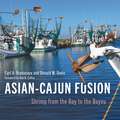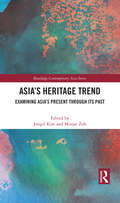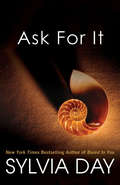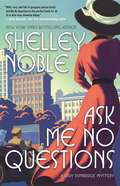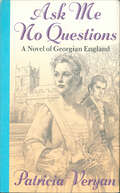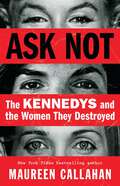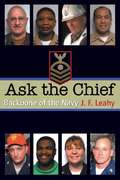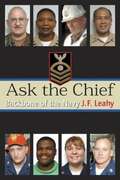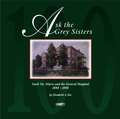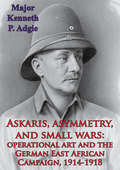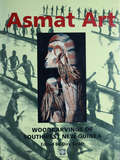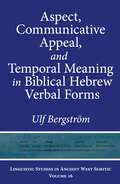- Table View
- List View
Asian-Cajun Fusion: Shrimp from the Bay to the Bayou (America's Third Coast Series)
by Carl A. Brasseaux Donald W. DavisShrimp is easily America’s favorite seafood, but its very popularity is the wellspring of problems that threaten the shrimp industry’s existence. Asian-Cajun Fusion: Shrimp from the Bay to the Bayou provides insightful analysis of this paradox and a detailed, thorough history of the industry in Louisiana. Dried shrimp technology was part of the cultural heritage Pearl River Chinese immigrants introduced into the Americas in the mid-nineteenth century. As early as 1870, Chinese natives built shrimp-drying operations in Louisiana’s wetlands and exported the product to Asia through the port of San Francisco. This trade internationalized the shrimp industry. About three years before Louisiana’s Chinese community began their export endeavors, manufactured ice became available in New Orleans, and the Dunbar family introduced patented canning technology. The convergence of these ancient and modern technologies shaped the evolution of the northern Gulf Coast’s shrimp industry to the present. Coastal Louisiana’s historic connection to the Pacific Rim endures. Not only does the region continue to export dried shrimp to Asian markets domestically and internationally, but since 2000 the region’s large Vietnamese immigrant population has increasingly dominated Louisiana’s fresh shrimp harvest. Louisiana shrimp constitute the American gold standard of raw seafood excellence. Yet, in the second decade of the twenty-first century, cheap imports are forcing the nation’s domestic shrimp industry to rediscover its economic roots. “Fresh off the boat” signs and real-time internet connections with active trawlers are reestablishing the industry’s ties to local consumers. Direct marketing has opened the industry to middle-class customers who meet the boats at the docks. This “right off the boat” paradigm appears to be leading the way to reestablishment of sustainable aquatic resources. All-one-can-eat shrimp buffets are not going to disappear, but the Louisiana shrimp industry’s fate will ultimately be determined by discerning consumers’ palates.
Asia’s Heritage Trend: Examining Asia’s Present through Its Past (Routledge Contemporary Asia Series)
by Jongil Kim Minjae ZoeKim and Zoh bring together a team of contributors to analyse the role of heritage studies across Asia, and its impact on Asia and its constituent countries. Is there such a thing as ‘Asian heritage’? Is it more helpful to understand Asia as a single unit, or as a set of sub- regions? What can we learn about Asia’s present through its archaeology and heritage? Covering a wide range of countries, including Afghanistan, Cambodia, China, Korea, Laos, Myanmar, Japan, Taiwan, Thailand and Vietnam, the contributors to this book address these key questions. In doing so they look at a number of critical issues, such as UNESCO World Heritage status, cultural propaganda, cultural erasure and difficult heritage. While addressing Asia’s past they also observe key issues within present- day Asia, further providing conceptual and practical insights into the methods that are being applied to the study of Asia’s heritage today. A valuable resource for scholars and students of Asian history and culture, archaeology, heritage studies, anthropology and religious studies.
Ask A Historian: 50 Surprising Answers to Things You Always Wanted to Know
by Greg Jenner'Jenner uses all the questions you never dared to ask about history as an excellent excuse to rummage around in some funny, fascinating, and downright peculiar corners of the past. Every page contains delights, and you will be illuminated and entertained in equal measure.' Lindsey Fitzharris, author of The Butchering Art'If history informs our future, Greg Jenner is one of the best informants out there. He is a natural story-teller, conveying complex ideas and events with pep, verve, and wit. For anyone who regularly asks the question 'Why?', this book is for you.' Susie Dent, author of Word Perfect Why is Italy called Italy? How old is curry? Which people from history would best pull off a casino heist? Who was the richest person of all time? When was the first Monday? What were history's weirdest medical procedures that actually worked? How much horse manure was splattered on the streets of Tudor London? How fast was the medieval Chinese postal system? What did the Flintstones get right about the Stone Age? Who gets to name historical eras, and what will ours be called in 100 years' time? How do we know how people sounded in the past? How old is sign language? In Ask a Historian the author, BBC podcaster, and public historian Greg Jenner provides answers to things you always wondered about, but didn't know who to ask. Responding to 50 genuine questions from the public, Greg whisks you off on an entertaining tour through the ages, revealing the best and most surprising stories, facts, and historical characters from the past. Bouncing through a wide range of subjects - from ancient jokebooks, African empires, and bizarre tales of medicinal cannibalism, to the invention of meringues, mirrors, and menstrual pads - Ask A Historian spans the Stone Age to the Swinging Sixties, and offers up a deliciously amusing and informative smorgasbord of historical curiosities, devoured one morsel at a time.
Ask A Historian: 50 Surprising Answers to Things You Always Wanted to Know
by Greg Jenner'Jenner uses all the questions you never dared to ask about history as an excellent excuse to rummage around in some funny, fascinating, and downright peculiar corners of the past. Every page contains delights, and you will be illuminated and entertained in equal measure.' Lindsey Fitzharris, author of The Butchering Art'If history informs our future, Greg Jenner is one of the best informants out there. He is a natural story-teller, conveying complex ideas and events with pep, verve, and wit. For anyone who regularly asks the question 'Why?', this book is for you.' Susie Dent, author of Word Perfect Why is Italy called Italy? How old is curry? Which people from history would best pull off a casino heist? Who was the richest person of all time? When was the first Monday? What were history's weirdest medical procedures that actually worked? How much horse manure was splattered on the streets of Tudor London? How fast was the medieval Chinese postal system? What did the Flintstones get right about the Stone Age? Who gets to name historical eras, and what will ours be called in 100 years' time? How do we know how people sounded in the past? How old is sign language? In Ask a Historian the author, BBC podcaster, and public historian Greg Jenner provides answers to things you always wondered about, but didn't know who to ask. Responding to 50 genuine questions from the public, Greg whisks you off on an entertaining tour through the ages, revealing the best and most surprising stories, facts, and historical characters from the past. Bouncing through a wide range of subjects - from ancient jokebooks, African empires, and bizarre tales of medicinal cannibalism, to the invention of meringues, mirrors, and menstrual pads - Ask A Historian spans the Stone Age to the Swinging Sixties, and offers up a deliciously amusing and informative smorgasbord of historical curiosities, devoured one morsel at a time.
Ask A Historian: 50 Surprising Answers to Things You Always Wanted to Know
by Greg JennerIf history informs our future, Greg Jenner is one of the best informants out there. He is a natural story-teller, conveying complex ideas and events with pep, verve, and wit. For anyone who regularly asks the question 'Why?', this book is for you.' Susie Dent, author of Word Perfect Why is Italy called Italy? How old is curry? Which people from history would best pull off a casino heist? Who was the richest person of all time? When was the first Monday? What were history's weirdest medical procedures that actually worked? How much horse manure was splattered on the streets of Tudor London? How fast was the medieval Chinese postal system? What did the Flintstones get right about the Stone Age? Who gets to name historical eras, and what will ours be called in 100 years' time? How do we know how people sounded in the past? How old is sign language? In Ask a Historian the author, BBC podcaster, and public historian Greg Jenner provides answers to things you always wondered about, but didn't know who to ask. Responding to 50 genuine questions from the public, Greg whisks you off on an entertaining tour through the ages, revealing the best and most surprising stories, facts, and historical characters from the past. Bouncing through a wide range of subjects - from ancient jokebooks, African empires, and bizarre tales of medicinal cannibalism, to the invention of meringues, mirrors, and menstrual pads - Ask A Historian spans the Stone Age to the Swinging Sixties, and offers up a deliciously amusing and informative smorgasbord of historical curiosities, devoured one morsel at a time.
Ask For It (Georgian #1)
by Sylvia DayFrom the #1 New York Times-bestselling author of Bared to You: &“Plenty of sizzling passion and dangerous drama.&”—Booklist Though he&’s experienced much as an agent to the Crown, nothing incites Marcus more than the primal hunger roused by his former fiancée, Lady Elizabeth. It's been years since she jilted him for another man, but that only means there's a lot to catch up on, a lot to make up for, and that he's going to enjoy every sweet moment. . . The same drive and passion that sent her into another man's arms is what brings Elizabeth back to Marcus. Her attraction to him is the one thing she fears, but she's run out of options. Resisting is impossible. But does she have the courage to surrender everything?Praise for Sylvia Day and her novels "Bared to You obliterates the competition. . .unique and unforgettable." -Joyfully Reviewed "The undisputed mistress of tender, erotic romance." --Teresa Medeiros
Ask Me No Questions: A Lady Dunbridge Mystery (A Lady Dunbridge Mystery #1)
by Shelley NobleFrom New York Times bestselling author Shelley Noble, Ask Me No Questions is the first in the Lady Dunbridge Mystery series featuring a widow turned sleuth in turn-of-the-twentieth century New York City. <p><p> A modern woman in 1907, Lady Dunbridge is not about to let a little thing like the death of her husband ruin her social life. She’s ready to take the dazzling world of Gilded Age Manhattan by storm. From the decadence of high society balls to the underbelly of Belmont horse racing, romance, murder, and scandals abound. Someone simply must do something. And Lady Dunbridge is happy to oblige.
Ask Me No Questions: A Novel of Georgian England (The Tales of the Jewelled Men #3)
by Patricia Veryan"A worthy successor to Georgette Heyer at her very best," says the Chattanooga Times of Patricia Veryan, whose latest gem in The Tales of the Jeweled Men introduces perhaps her most vibrant and resourceful heroine to date. Young Ruth Allington is a woman in exceptionally dire straits. Her father, brother, and husband have died, leaving her with a disgraced family name, an estate in debt, and two small nephews to support. Her few assets include a quick mind, a superb artistic ability, and her new friendship with the generous–and crafty–Gwendolyn Rossiter...Ask Me No Questions follows Time's Fool and Had We Never Loved in The Tales of the Jeweled Men.
Ask Not
by Thurston Clarke2013 is the 50th Anniversary of JFK’s assassination. A narrative of Kennedy's quest to create a speech that would distill American dreams and empower a new generation, Ask Not is a beautifully detailed account of the inauguration and the weeks preceding it. During a time when America was divided, and its citizens torn by fears of war, John F. Kennedy took office and sought to do more than just reassure the American people. His speech marked the start of a brief, optimistic era. Thurston Clarke's portrait of JFK is balanced, revealing the president at his most dazzlingly charismatic and cunningly pragmatic. Thurston Clarke's latest book, JFK's Last Hundred Days, is currently available in hardcover. .
Ask Not: The Kennedys and the Women They Destroyed
by Maureen CallahanThe Kennedy name has long been synonymous with wealth, power, glamor, and—above all else—integrity. But this carefully constructed veneer hides a dark truth: the pattern of Kennedy men physically and psychologically abusing women and girls, leaving a trail of ruin and death in each generation’s wake. Through decades of scandal after scandal—from sexual assaults to reputational slander, suicides to manslaughter—the family and their defenders have kept the Kennedy brand intact. Now, in Ask Not, bestselling author and journalist Maureen Callahan reveals the Kennedys’ hidden history of violence and exploitation, laying bare their unrepentant sexism and rampant depravity while also restoring these women and girls to their rightful place at the center of the dynasty’s story: from Jacqueline Onassis and Marilyn Monroe to Carolyn Bessette, Martha Moxley, Mary Jo Kopechne, Rosemary Kennedy, and many others whose names aren’t nearly as well known but should be. <P><P> Drawing on years of explosive reportage and written in electric prose, Ask Not is a long-overdue reckoning with this fabled family and a consequential part of American history that is still very much with us. At long last, Callahan redirects the spotlight to the women in the Kennedys’ orbit, paying homage to those who freed themselves and giving voice to those who, through no fault of their own, could not. <p> <b>New York Times Bestseller</b>
Ask and Tell
by Steve EstesDon't Ask, Don't Tell" was the directive of President Clinton's 1993 military policy regarding gay and lesbian soldiers. This official silence continued a collective amnesia about the patriotic service and courageous sacrifices of homosexual troops. Ask and Tell recovers these lost voices, offering a rich chronicle of the history of gay and lesbian service in the U.S. military from World War II to the Iraq War. Drawing on more than 50 interviews with gay and lesbian veterans, Steve Estes charts the evolution of policy toward homosexuals in the military over the past 65 years, uncovering the ways that silence about sexuality and military service has affected the identities of gay veterans. These veteran voices--harrowing, heroic, and on the record--reveal the extraordinary stories of ordinary Americans, men and women who simply did their duty and served their country in the face of homophobia, prejudice, and enemy fire. Far from undermining national security, unit cohesion, or troop morale, Estes demonstrates, these veterans strengthened the U.S. military in times of war and peace. He also examines challenges to the ban on homosexual service, placing them in the context of the wider movement for gay rights and gay liberation. Ask and Tell is an important compilation of unheard voices, offering Americans a new understanding of the value of all the men and women who serve and protect them.The official silence mandated by the 1993 "Don't Ask, Don't Tell" policy continued a collective amnesia about the patriotic service and courageous sacrifices of homosexual troops. Ask and Tell recovers these lost voices, offering a rich chronicle of the history of gay and lesbian service in the U.S. military from World War II to the Iraq War. Drawing on more than 50 interviews with gay and lesbian veterans, Steve Estes charts the evolution of policy toward homosexuals in the military over the past 65 years, uncovering the ways that silence about sexuality and military service has affected the identities of gay veterans. These veteran voices--harrowing, heroic, and on the record--reveal the extraordinary stories of ordinary Americans, men and women who simply did their duty and served their country in the face of homophobia, prejudice, and enemy fire. -->
Ask of Old Paths: Medieval Virtues and Vices for a Whole and Holy Life
by Grace HammanTraditional Christian virtue and vices like abstinence, gluttony, and sloth make many of us bored or uncomfortable. At their best, these words sound dead or confusing, like incomplete fossils that belong to a distant past awkwardly enshrined in a museum. At worst, they signify a prejudiced past, when these words were wielded like weapons.Yet in medieval writing, the language of the virtues and vices was powerful, lively, and delightfully weird. Patience is described as a peppercorn. Unicorns preach chastity. Knightly virtues fend off devious vices by throwing roses at them. In medieval books, words like avarice and meekness meant different things and carried different weight than they do today. And great medieval preachers and poets taught the virtues as crucial to what it meant to live a life of holiness, right alongside the Lord's Prayer and the Creed.Ask of Old Paths by Grace Hamman meditates upon those strange and wonderful word-pictures and explanations of virtues and vices found in medieval traditions of poetry, sermons, and treatises long confined to dusty corners of the library. It focuses on the ancient tradition of virtue language called the Seven Capital Virtue Remedies: pride and humility, envy and love, wrath and meekness, avarice and mercy, sloth and fortitude, gluttony and abstinence, lust and chastity.In accessible and thoughtful chapters, scholar and writer Grace Hamman shows how learning about these pairs of medieval virtues and vices can help us reevaluate our own washed out and insipid moral vocabulary in modernity. Our imaginations for the good life are expanded; our longing for sanctification sharpens. Old ideas can give us new fire in our practice of the virtue--and in that practice, we imitate Jesus and become more human.
Ask the Chief
by John F. LeahyWhenever sailors are confronted with 'unsolvable' problems--be it a fouled anchor or paint that won't dry--they often throw up their hands and exclaim, 'We'd better ask the Chief.' That refrain, heard for generations throughout the Navy, is the theme for Jack Leahy's newest book. Written at sea, his book provides a compelling picture of the Chief Petty Officer's community in the U.S. Navy.As a guest of the Chief Petty Officer's mess aboard USS George Washington during Operation Enduring Freedom, Leahy was granted complete and unfettered access to all areas of the massive carrier and the other ships in her battle group. He interviewed nearly one hundred Navy Chiefs from the aviation, surface, submarine, and special warfare communities and recounts their stories of daily life at sea. In doing so, he presents the true backbone of the modern Navy: the wisdom, character, and dignity of the Chief Petty Officer's community. This book of contemporaneous oral history follows the format that proved so successful with Leahy's earlier book on Navy boot camp. Color photographs help bring the story to life.
Ask the Chief: Backbone of the Navy
by J. F. LeahyAs a guest of the chief petty officers mess aboard USS George Washington during Operation Enduring Freedom, Leahy was granted complete and unfettered access to all areas of the massive carrier as well as the other ships in her battle group.
Ask the Grey Sisters: Sault Ste. Marie and the General Hospital, 1898-1998
by Elizabeth A. IlesAsk the Grey Sisters: Sault Ste. Marie and the General Hospital, 1898-1998 tells the story of the creation and one-hundred-year history of the Sault Ste. Marie General Hospital. At a time when Canada’s healthcare system is at a crossroads and we are asked to make crucial decisions for its future, it is intriguing and enlightening to look at the colourful past of a typical community hospital. Throughout the 1890s, Sault Ste. Marie was a town in search of a hospital. Its glory days at the centre of the fur-trade route were long gone and the Sault was in the process of becoming a modern industrial community. Such a community needed a hospital as a centrepiece to attract investors and as a necessary social institution to care for the hundreds of workers who were flocking to town without family support. The General Hospital was established in 1898 after the town committee charged with developing a hospital had been refused funding by both the federal and provincial governments. In desperation, the committee met with the provincial Inspector of Asylums and Prisons (the only provincial official with hospitals in his mandate). "If you wish a hospital of which the work is serious and lasting," he is reported to have advised them, "ask the Grey Sisters." And so began a fruitful association between the community of Sault Ste. Marie and two orders of Grey Sisters who have operated the hospital through its one-hundred-year history. Based in part on the extensive archival collections of both orders of nuns, this history includes material from the sisters’ Chronicles and their personal reminiscences. The result is an intimate and detailed portrait of a community hospital, placed in the context of an emerging provincial system of health care.
Askaris, Asymmetry, And Small Wars: Operational Art And The German East African Campaign, 1914-1918
by Major Kenneth P. AdgieThis monograph analyzed whether Lieutenant Colonel Paul von Lettow-Vorbeck used operational art to defeat British forces in the East African campaign of World War I. British forces were superior in quantity of men and equipment, but slow moving and heavily dependent on secure lines of communication. Lettow-Vorbeck's forces maintained an asymmetric advantage in mobility, knowledge of terrain, and responsive logistics. An analogy was suggested that the U.S. Army in the twenty-first century is similar to British forces in 1914, and the nation's future adversaries could potentially use Lettow-Vorbeck's unconventional warfare and asymmetric tactics woven together in a comprehensive campaign plan.This monograph reviewed the origins and characteristics of operational art. The Army's emerging doctrine, Student Text 3-0, Operations defines operational art as the "use of military force to achieve strategic goals through the design, organization, integration, and conduct of theater strategic, campaigns, major operations, and battles" and serves as the entry point for discussion. A synthesis of Shimon Naveh and James Schneider's theories revealed five primary characteristics of operational art and was used as the criteria to evaluate the research question. The five characteristics were: operational objectives, operational maneuver, disruption, operational approach, and operational logistics. The East African campaign was analyzed from the perspective of Lettow-Vorbeck linking his strategic aim of forcing the British to commit forces to a secondary theater of operations to his limited resources. The four-year campaign was divided into three phases based on Lettow-Vorbeck's operational objectives and the correlation of forces. Significant tactical vignettes were examined as part of an overarching campaign plan. Finally, this monograph considered how the U.S. Army would fight an asymmetric enemy in a similar environment.
Asking for a Friend: Three Centuries of Advice on Life, Love, Money, and Other Burning Questions from a Nation Obsessed
by Jessica WeisbergA delightful history of Americans' obsession with advice--from Poor Richard to Dr. Spock to Miss MannersAmericans, for all our talk of pulling ourselves up by our bootstraps, obsessively seek advice on matters large and small. Perhaps precisely because we believe in bettering ourselves and our circumstances in life, we ask for guidance constantly. And this has been true since our nation's earliest days: from the colonial era on, there have always been people eager to step up and offer advice, some of it lousy, some of it thoughtful, but all of it read and debated by generations of Americans.Jessica Weisberg takes readers on a tour of the advice-givers who have made their names, and sometimes their fortunes, by telling Americans what to do. You probably don't want to follow all the advice they proffered. Eating graham crackers will not make you a better person, and wearing blue to work won't guarantee a promotion. But for all that has changed in American life, it's a comfort to know that our hang-ups, fears, and hopes have not. We've always loved seeking advice--so long as it's anonymous, and as long as it's clear that we're not asking for ourselves; we're just asking for a friend.
Asking the Audience: Participatory Art in 1980s New York
by Adair RounthwaiteThe 1980s was a critical decade in shaping today&’s art production. While newly visible work concerned with power and identity hinted at a shift toward multiculturalism, the &‘80s were also a time of social conservatism that resulted in substantial changes in arts funding. In Asking the Audience, Adair Rounthwaite uses this context to analyze the rising popularity of audience participation in American art during this important decade.Rounthwaite explores two seminal and interrelated art projects sponsored by the Dia Art Foundation in New York: Group Material&’s Democracy and Martha Rosler&’s If You Lived Here…. These projects married issues of social activism—such as homelessness and the AIDS crisis—with various forms of public participation, setting the precedent for the high-profile participatory practices currently dominating global contemporary art. Rounthwaite draws on diverse archival images, audio recordings, and more than thirty new interviews to analyze the live affective dynamics to which the projects gave rise. Seeking to foreground the audience experience in understanding the social context of participatory art, she argues that affect is key to the audience&’s ability to exercise agency within the participatory artwork.From artists and audiences to institutions, funders, and critics, Asking the Audience traces the networks that participatory art creates between various agents, demonstrating how, since the 1980s, leftist political engagement has become a cornerstone of the institutionalized consumption of contemporary art.
Asleep
by Molly Caldwell CrosbyA fascinating look at a bizarre, forgotten epidemic from the national bestselling author of The American Plague. In 1918, a world war raged, and a lethal strain of influenza circled the globe. In the midst of all this death, a bizarre disease appeared in Europe. Eventually known as encephalitis lethargica, or sleeping sickness, it spread worldwide, leaving millions dead or locked in institutions. Then, in 1927, it disappeared as suddenly as it arrived. Asleep, set in 1920s and '30s New York, follows a group of neurologists through hospitals and asylums as they try to solve this epidemic and treat its victims-who learned the worst fate was not dying of it, but surviving it.
Asleep
by Molly Caldwell CrosbyA fascinating look at a bizarre, forgotten epidemic from the national bestselling author of The American Plague. In 1918, a world war raged, and a lethal strain of influenza circled the globe. In the midst of all this death, a bizarre disease appeared in Europe. Eventually known as encephalitis lethargica, or sleeping sickness, it spread worldwide, leaving millions dead or locked in institutions. Then, in 1927, it disappeared as suddenly as it arrived. Asleep, set in 1920s and '30s New York, follows a group of neurologists through hospitals and asylums as they try to solve this epidemic and treat its victims-who learned the worst fate was not dying of it, but surviving it.
Asmat Art
by Dirk SmidtThis book presents a full range of Asmat woodcarving art, but emphasizes the rare early shields and figure sculptures in the collection of the Rijksmuseum voor Volkenkunde, the National Museum of Ethnology in Leiden. Drums, canoeprowheads and the larger, more dramatic "objects" are also shown. * Together with bisj poles, war shields are perhaps the most famous creation of Asmat artists, and these were carved throughout the region. It is in the design and construction of the shields that the variations in style region can most clearly be seen. Figure sculptures, of varying styles, are also well represented here, and a limited number of the huge ceremonial carvings, such as bisj poles and basu suangkus, have also been included. The cultural context in which these items play their part is described in detail in the introductory chapters. But it is not the intention of this book to be an ethnography. The focus is on the art pieces themselves.
Asotin County (Images of America)
by Jeri Jackson McguireAsotin, Anatone, Cloverland, Clarkston, and Silcott are all towns within Asotin County, an area rich in local history. Names like Lewis and Clark, Chief Joseph, Capt. Benjamin Bonneville, Capt. Edward Steptoe, Chief Looking Class, Chief Timothy, and Henry Spaulding all had early ties to the area. Asotin was carved out of Garfield County on October 27, 1883. There are fascinating stories of early pioneers, such as Weissenfels, Floch, Wilson, Stone, Critchfield, Halsey, and many more, who came from far and wide to settle the area, becoming farmers, building towns, and establishing an irrigation system. Through the years, Asotin has encountered floods, murders, hangings, a disastrous fire, and a fight to retain the county seat. At one point, the residents thought they might have to battle the Nez Perce Indians, but they were peaceful and very kind to the people.
Aspect, Communicative Appeal, and Temporal Meaning in Biblical Hebrew Verbal Forms (Linguistic Studies in Ancient West Semitic #16)
by Ulf BergströmThis book provides a new explanation for what has long been a challenge for scholars of Biblical Hebrew: how to understand the expression of verbal tense and aspect.Working from a representative text corpus, combined with database queries of specific usages and surveys of examples discussed in the scholarly literature, Ulf Bergström gives a comprehensive overview of the semantic meanings of the verbal forms, along with a significant sample of the variation of pragmatically inferred tense, aspect, or modality (TAM) meanings. Bergström applies diachronic typology and a redefined concept of aspect to demonstrate that Biblical Hebrew verbal forms have basic aspectual and derived temporal meanings and that communicative appeal, the action-triggering function of language, affects verbal semantics and promotes the diversification of tense meanings. Bergström’s overarching explanation of the semantic development of the Biblical Hebrew verbal system is an important contribution to the study of the evolution of the verbal system and meanings of individual verbs in the Hebrew Bible. Accessibly written and structured for seminar use, Bergström’s study brings new perspectives to a debate that, in many ways, had reached a stalemate, and it challenges scholars working with TAM and the Biblical Hebrew verb to revisit their theoretical premises. Advanced students and scholars of Biblical Hebrew and other Semitic languages will find the study thought provoking, and linguists will appreciate its contributions to linguistic theory and typology.
Aspect, Communicative Appeal, and Temporal Meaning in Biblical Hebrew Verbal Forms (Linguistic Studies in Ancient West Semitic)
by Ulf BergströmThis book provides a new explanation for what has long been a challenge for scholars of Biblical Hebrew: how to understand the expression of verbal tense and aspect.Working from a representative text corpus, combined with database queries of specific usages and surveys of examples discussed in the scholarly literature, Ulf Bergström gives a comprehensive overview of the semantic meanings of the verbal forms, along with a significant sample of the variation of pragmatically inferred tense, aspect, or modality (TAM) meanings. Bergström applies diachronic typology and a redefined concept of aspect to demonstrate that Biblical Hebrew verbal forms have basic aspectual and derived temporal meanings and that communicative appeal, the action-triggering function of language, affects verbal semantics and promotes the diversification of tense meanings. Bergström’s overarching explanation of the semantic development of the Biblical Hebrew verbal system is an important contribution to the study of the evolution of the verbal system and meanings of individual verbs in the Hebrew Bible. Accessibly written and structured for seminar use, Bergström’s study brings new perspectives to a debate that, in many ways, had reached a stalemate, and it challenges scholars working with TAM and the Biblical Hebrew verb to revisit their theoretical premises. Advanced students and scholars of Biblical Hebrew and other Semitic languages will find the study thought provoking, and linguists will appreciate its contributions to linguistic theory and typology.
Aspects Of Western Civilization: Problems And Sources In History, Volume 2
by Perry RogersAspects of Western Civilization : Problems and Sources in History, Volume 1, 7/e, challenges students with basic questions regarding historical development, human nature, moral action, and practical necessity. This collection of diverse primary sources explores a wide variety of issues and is organized around seven major themes: the Power Structure, Social and Spiritual Values, the Institution and the Individual, Imperialism, Revolution and Historical Transition, the Varieties of Truth, and Women in History.
